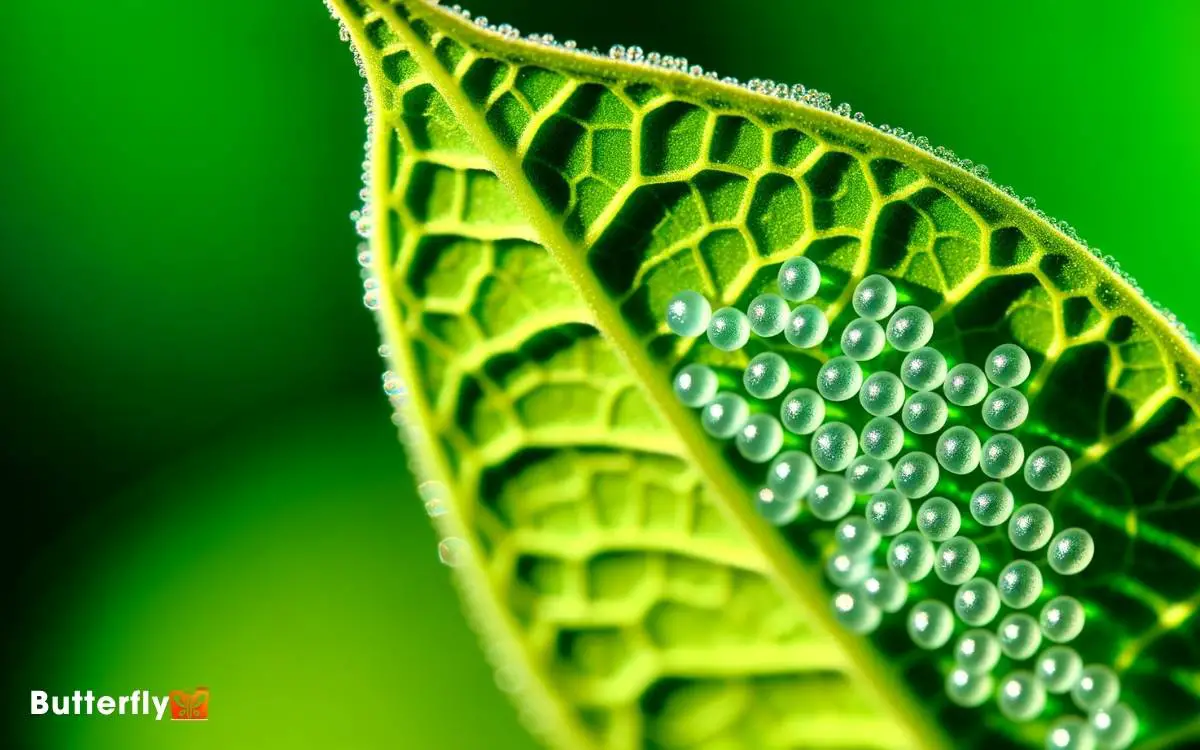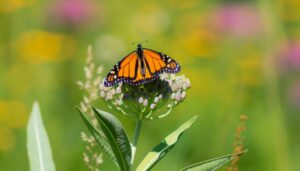Images of Monarch Butterfly Eggs: Find Out Here!
When you observe monarch butterfly eggs, you’ll find they are off-white, pale cream, or light green and measure about 1.2 millimeters long and 0.9 millimeters wide.
These oval-shaped eggs have a ribbed texture and are usually found singly on the underside of milkweed leaves. Females lay each egg using a special glue to guarantee it stays attached.
Monarch eggs possess hydrophobic properties and darken before hatching. Their strategic placement and chemical deterrents protect them from predators like ants and spiders. If you’re curious about their fascinating development stages, there’s much more to discover.

Key Takeaways
Discovery of Monarch Eggs
Upon closely examining milkweed leaves, you’ll often discover the tiny, off-white, oval-shaped eggs of the monarch butterfly, usually measuring about 1.2 millimeters in length.
These eggs are typically deposited singly on the underside of the leaves. When you look carefully, you’ll note the eggs’ smooth texture and slight glistening under light.
The placement is essential; it guarantees the emerging caterpillars have immediate access to their primary food source.
It’s important to use a magnifying glass for accurate identification, as the small size can make them easy to overlook.
Observing the eggs’ distribution and condition can provide insights into the local monarch population’s health and behavior, making your detailed observations invaluable for conservation efforts.
Egg Shape and Size
The monarch butterfly egg is distinctly oval-shaped and measures approximately 1.2 millimeters in length, making precise identification essential for accurate research and observation.
When examining the egg, you’ll notice its ribbed surface texture, which sets it apart from other species. These vertical ridges run from the base to the apex, offering structural integrity. The egg’s width is about 0.9 millimeters, contributing to its diminutive size.
Utilizing a magnifying lens, you can observe these fine details, aiding in correct species identification. Precision in measuring and noting these aspects guarantees accurate data collection and analysis.
Egg Color Variations
Despite being small, monarch butterfly eggs exhibit subtle color variations ranging from pale cream to light green, which can be crucial for accurate identification.
When observing these eggs, you’ll notice slight differences in hue that can provide clues about the developmental stage and environmental conditions.
Here’s a detailed look at the predominant color variations:
| Color | Description |
|---|---|
| Pale Cream | Newly laid, often fresh eggs |
| Light Green | Possibly older, more mature |
| Off-White | Intermediate stage |
| Yellowish Tint | May indicate environmental factors |
These color distinctions, though subtle, offer essential insights. Pale cream eggs are generally newly laid, while light green may signal older eggs.
Off-white eggs might be in an intermediate stage, and a yellowish tint could point to specific environmental influences.
Egg-Laying Behavior
Understanding the color variations of monarch butterfly eggs provides a foundation for exploring the intricate behaviors females exhibit while laying eggs.
You’ll observe that a female monarch, Danaus plexippus, meticulously inspects potential sites, using her forelegs to drum on the leaf surface. This action allows her to detect chemical cues indicating suitability.
She often curls her abdomen to lay a single, conical egg, measuring approximately 1.2 mm in height and 0.9 mm in diameter. The process takes mere seconds but is repeated up to 400 times over her lifespan.
She strategically spaces eggs to guarantee larvae have ample resources, demonstrating an innate understanding of plant-host dynamics.
Observing these behaviors highlights the precision and complexity of monarch reproductive strategies.
Preferred Egg Sites
When examining Monarch butterfly egg-laying preferences, you’ll notice a strong inclination for the underside of leaves, particularly on milkweed plants. These locations provide ideal microclimates and minimize predation risk.
Pay attention to the 2-3 cm zone on the leaf where eggs are most frequently deposited.
Leaf Underside Preference
Monarch butterflies often lay their eggs on the underside of leaves, where the microclimate maintains essential humidity levels and protects the eggs from direct sunlight and predators.
You’ll observe that these conditions are vital for the eggs’ development. The underside of leaves generally exhibits higher humidity levels, ranging from 70% to 90%, which prevents desiccation.
Additionally, the leaf structure itself provides a natural barrier against many predators. The preference for the underside also reduces the likelihood of UV damage, enhancing egg viability.
| Condition | Leaf Underside | Leaf Upper-side |
|---|---|---|
| Humidity Level | 70%-90% | 50%-70% |
| UV Exposure | Low | High |
| Predator Access | Restricted | Exposed |
| Temperature | Stable | Fluctuates |
| Egg Viability | High | Low |
Understanding these factors helps you appreciate the monarch’s reproductive strategy.
Milkweed Plant Selection
Female monarch butterflies exhibit a distinct preference for laying their eggs on specific milkweed species, primarily Asclepias syriaca and Asclepias incarnata, due to their ideal chemical and physical properties.
When selecting egg sites, you’ll notice they display meticulous behavior, favoring plants with:
- High cardenolide concentration for larval toxicity defense
- Leaf surface trichomes providing better attachment
- Optimal leaf thickness for egg anchorage
- Adequate moisture content ensuring egg viability
- Absence of fungal contamination maintaining egg integrity
These selections are based on precise interaction with the milkweed’s phytochemical profiles and morphological characteristics.
You’ll see that their choices maximize offspring survival and reflect evolutionary adaptations to enhance reproductive success. Understanding these preferences helps in conservation efforts, ensuring the availability of suitable milkweed habitats.
Avoiding Predatory Zones
Selecting egg sites, female monarch butterflies actively avoid predatory zones by choosing locations with lower predator activity, guaranteeing higher survival rates for their offspring.
You’ll notice that monarchs prefer the underside of milkweed leaves, which offers concealment from predators. They also target younger, tender leaves where fewer herbivores gather.
Female monarchs can detect chemical cues indicating predator presence, thereby avoiding such areas.
| Observation | Measurement | Detail |
|---|---|---|
| Leaf Selection | Underside, lower leaves | Less predator visibility |
| Plant Age | Younger plants | Fewer herbivores |
| Predator Cues | Chemical detection | Avoids predator-laden zones |
| Egg Placement | Isolated spots | Higher egg survival |
| Predatory Avoidance | Active choice | Ensures offspring safety |
Egg Close-Up Images
A high-resolution image reveals the intricate surface texture and subtle coloration of a Monarch butterfly egg, measuring approximately 1.2 millimeters in length.
You’ll notice the eggs’ essential ribbed structure, which is crucial for identification and study. Each egg displays a unique pattern of ridges and grooves, enhancing its structural integrity.
Here’s what you’ll observe in a close-up image:
- Microscopic ridges: These fine lines run vertically from the base to the apex.
- Subtle coloration: The eggs are typically pale cream or off-white.
- Oval shape: Slightly elongated, tapering to a pointed top.
- Surface texture: A delicate, almost translucent sheen.
- Size: Precisely around 1.2 millimeters in length, making them quite delicate.
Understanding these details will help you appreciate the complexity of these tiny marvels.
Egg Development Stages
You’ll find that Monarch butterfly eggs undergo a series of meticulously timed developmental stages, each marked by specific morphological changes and cellular activities.
Initially, the egg appears translucent and oval, measuring approximately 1.2 mm in length. As embryogenesis begins, cellular differentiation becomes evident with the formation of the blastoderm.
By day three, segmentation starts, and the developing larva’s head and thoracic segments can be discerned. The chorion, or eggshell, gradually becomes more opaque.
By day four or five, tracheal gill structures form, visible through the shell. At this stage, the larva exhibits slight movements.
Just before hatching, the egg darkens as the fully formed larva prepares to emerge, completing the intricate process of metamorphosis.
Predators of Monarch Eggs
As the Monarch butterfly eggs progress through their developmental stages, they become increasingly vulnerable to a variety of predators.
You’ll find that these tiny, delicate eggs are targeted by numerous arthropods and other small creatures. Precise observations have identified the primary predators.
- Ants (Formicidae): Swiftly dismantle eggs, consuming them within minutes.
- Spiders (Araneae): Ensnare eggs in silk, leading to eventual consumption.
- Lady Beetles (Coccinellidae): Often devour eggs whole, showing a preference for Monarch eggs.
- Shield Bugs (Pentatomidae): Puncture eggs with their proboscis, extracting nutrients.
- Earwigs (Dermaptera): Active nocturnal predators, consuming eggs on contact.
Each predator employs distinct methods to exploit the Monarch eggs, necessitating a keen understanding of these threats for effective conservation.
Egg Protection Strategies
You’ll notice that monarch butterfly eggs exhibit several defense mechanisms against natural predators. These strategies include the secretion of chemical deterrents and the strategic placement of eggs on the undersides of milkweed leaves to minimize predation.
Additionally, environmental adaptations such as the eggs’ camouflage coloration contribute to their protection by blending with their surroundings.
Natural Predators Defense
Monarch butterfly eggs employ a range of defense mechanisms to minimize predation, ensuring the survival of the species.
These strategies include chemical deterrents and strategic oviposition on milkweed plants. The milkweed plants themselves contain toxic compounds called cardenolides, which the eggs and larvae absorb, making them unpalatable to many predators.
Female monarchs choose specific milkweed species that provide the best protection.
- Chemical deterrents: Cardenolides absorbed from milkweed deter predators.
- Strategic oviposition: Females lay eggs on less accessible parts of the plant.
- Camouflage: Eggs blend with the milkweed’s color and texture.
- Egg clustering: Minimizes detection by predators.
- Ant mutualism: Some ants protect eggs in exchange for nectar.
These adaptations enhance egg survival against natural predators.
Environmental Adaptations
In addition to predator deterrence, these eggs exhibit remarkable environmental adaptations such as temperature tolerance and moisture regulation to guarantee their survival in varying climatic conditions.
Monarch butterfly eggs can withstand temperatures ranging from 12°C to 35°C without compromising embryonic development.
You’ve probably noticed how their microstructural layers prevent desiccation by minimizing water loss, maintaining a favorable internal environment.
Furthermore, these eggs are hydrophobic, allowing them to repel excess moisture during heavy rainfall, consequently preventing potential overhydration.
By examining the chorion, you’d observe fine reticulated patterns that contribute to mechanical strength and gas exchange efficiency.
These adaptations make sure that monarch butterfly eggs remain viable and resilient, even in fluctuating environmental conditions, enhancing their chances of successful hatching.
Egg to Caterpillar Transition
During the egg to caterpillar metamorphosis, you can observe the monarch embryo developing distinct features through the semi-transparent shell, typically within three to five days.
You’ll notice the formation of the head capsule, which is a clear indicator of impending hatching. The growing larva consumes the yolk inside the egg, providing essential nutrients for development.
As the days progress, the black head capsule becomes more visible. Key observations include:
- Duration: 3-5 days for development.
- Head Capsule Visibility: A sign of nearing hatching.
- Yolk Consumption: Nutrient absorption by the larva.
- Shell Transparency: Allows for detailed observation.
- Embryonic Movements: Subtle, but detectable.
These details reveal the intricate process leading to the emergence of the caterpillar from its egg.
Habitat for Egg Survival
You should focus on ensuring that monarch butterfly eggs are laid on ideal milkweed plants, which thrive in well-drained soil with a pH range of 6.5 to 7.5.
Be aware of common predators like ants and spiders that can reduce egg survival rates substantially.
Additionally, keep in mind that temperature fluctuations and humidity levels, ideally between 25-30°C and 60-80% respectively, are essential for egg development.
Optimal Milkweed Conditions
Healthy milkweed plants, characterized by robust leaves and minimal pesticide exposure, provide the ideal habitat for monarch butterfly eggs to thrive and develop.
You need to guarantee the milkweed plants are in peak condition by observing specific parameters:
- Soil pH: Maintain a level between 6.5 and 7.0 for best nutrient absorption.
- Moisture: Consistent soil moisture without waterlogging promotes healthy growth.
- Sunlight: Ensure full sunlight exposure for at least 6 hours daily.
- Spacing: Plant milkweed 18-24 inches apart to reduce competition for resources.
- Pesticide Use: Avoid chemical pesticides; opt for organic alternatives.
Predators and Threats
While maintaining ideal milkweed conditions is essential, equally important is protecting monarch butterfly eggs from predators and environmental threats. You’ll often find ants, spiders, and wasps preying on these eggs.
Detailed observations reveal that spiders, particularly in the Araneae order, can consume up to 30% of monarch eggs in certain habitats.
To mitigate these threats, you should consider using fine mesh netting around milkweed plants. Additionally, ground beetles (Carabidae family) are another significant predator.
Precise measurements show that these beetles can travel up to 10 meters in search of food, posing a substantial risk.
Climate Impact Factors
Understanding the impact of climate factors is essential for ensuring the survival of monarch butterfly eggs in their natural habitats. You need to take into account various environmental parameters that directly influence egg viability and development.
Key factors include:
- Temperature: Ideal range is 21-29°C; extremes can halt embryonic growth.
- Humidity: Best levels are 80-90%; low humidity desiccates eggs.
- Precipitation: Excessive rain can dislodge eggs from milkweed leaves.
- Wind Speed: High winds (above 20 km/h) can damage delicate eggs.
- Sunlight Exposure: Adequate sunlight is necessary for temperature regulation but overexposure can cause overheating.
Egg Identification Tips
Monarch butterfly eggs are typically less than 1.2 millimeters in diameter, often appearing as tiny, white, ribbed ovals on the underside of milkweed leaves. You’ll want to look for these minuscule eggs early in the morning when the light is less harsh.
Use a magnifying glass to examine the veins of the milkweed leaves closely. Note the distinctive ridges running vertically along the egg’s surface; these are a key identifying feature. If you spot a smooth, spherical egg, it’s likely not a monarch.
Also, check multiple leaves on a single plant since females often lay eggs in clusters. By paying attention to these details, you can confidently identify monarch butterfly eggs in their natural habitat.
Conclusion
You’ve learned about the fascinating journey of monarch butterfly eggs, from their distinct shape and size to their precise laying behavior.
Did you know a single female can lay up to 400 eggs? This amazing statistic highlights their reproductive potential.
By understanding egg color variations, preferred sites, and protection strategies, you can identify and help protect these delicate eggs.
Observing their shift to caterpillars offers a deeper appreciation for their complex lifecycle and the habitats critical for their survival.






